#26 aprile 1945
Text

Willow Run B-24 Assembly Line. By November 1943, they were rolling out a new B-24 every hour. At its peak monthly production (August 1944), Willow Run produced 428 B-24s with the highest production listed as 100 completed bombers flying away from Willow Run between April 24 and April 26, 1944. By 1945, Ford produced 70% of the B-24s in two 9-hour shifts. Ford built 6,972 of the 18,482 total B-24s and produced kits for 1,893 more to be assembled by the other manufacturers. The B-24 holds the distinction of being the most produced heavy bomber in history.
311 notes
·
View notes
Text
If you’re wanting to watch Band of Brothers/The Pacific/Masters of the Air in chronological order with BoB 1st Currahee episode split up in the dates on screen I made a list
(Updated: April 12, 2014 7:58pm pst)
July, 10 1942 Easy Company Trains in Camp Tocca (Band of Brothers Ep. 1 Currahee 2001)
August 7, 1942, Allied forces land on Guadalcanal (The Pacific Ep. 1 Guadalcanal/Leckie 2010)
September 18, 1942, 7th Marines Land on Guadalcanal (The Pacific Ep. 2 Basilone 2010)
December 1942 The 1st Marine Division on Guadalcanal is relieved (The Pacific Ep. 3 Melbourne 2010)
*June 23, 1943, Easy Company Trains in Camp Mackall N.C. (Band of Brothers Ep. 1 Currahee) *
June 25, 1943, 100th Bomb Group flew its first 8th Air Force combat mission (Master of the Air Ep. 1 2024)
July 16, 1943 the 100th Bomb Group bombed U-Boats in Tronbhdim (Masters of the Air Ep.2 2024)
August 17, 1943 the 4th Bomb Wing of the 100th Bomb Group bombed Regenberg (Masters of the Air Ep. 3 2024)
*September 6, 1943, Easy Company Boards transport ship in Brooklyn Naval Yard (Band of Brothers Ep. 1 Currahee)*
September 16, 1943, William Quinn and Charles Bailey leave Belgium (Masters of the Air Ep.4 2024)
September 18, 1943
-*East Company trains in Aldbourne, England (Band of Brothers Ep. 1 Currahee)*
-John 'Bucky' Egan returns from leave to join the mission to bomb Munster (Master of the Air Ep.5 2024)
October 14, 1943, John ‘Bucky’ Egan interrogated at Dulag Lut, Frankfurt Germany (Masters of the Air Ep. 6 2024)
December 26, 1943, 1st Marine Division lands on Cape Gloucester (The Pacific Ep. 4 Gloucester/Pavuvu/Banika 2010)
March 7, 1944, Stalag Luft III Sagan, Germany, Germans find the concealed radio Bucky was using to learn news of the War (Master of the Air Ep.7 2024)
*June 4, 1944, D-Day Invasion postponed (Band of Brothers Ep. 1 Currahee)*
*June 5, 1944 Easy Company Boards air transport planes bound for Normandy (Band of Brothers Ep. 1 Currahee)*
June 6, 1944, 00:48 & 01:40 First airborne troops begin to land on Normandy (Band of Brothers Ep. 2 Day of Days 2001)
June, 7 1944 Easy Company Takes Carentan (Band of Brothers 3x10 Carentan)
August 12, 1944, The 332nd Fighter Group attack Radar stations in Southern France (Masters of the Air Ep.8 2024)
September 15, 1944 U.S. Marines landed on Peleliu at 08:32, on September 15, 1944 (the Pacific Part Five: Peleliu Landing)
September 16, 1944 Marines take Peleliu airfield (the Pacific Part Six: Airfield)
September, 17 1944 Operation Market Garden -(Band of Brothers 4x10 Replacements)
October 22/23, 1944, 2100 – 0200 Operation Pegasus (Band of Brothers 5x10 Crossroads)
October, 1944 Battle of Peleliu continues (the Pacific Part Seven: Peleliu Hills)
December 16, 1944 Battle of the Bulge (Band of Brothers 6x10 Bastogne)
January, 1945 Battle of Foy (Band of Brothers 7x10 The Breaking Point)
February 14, 1945 David Webb rejoins the 506th in Haguenau (Band of Brothers 8x10 The Last Patrol)
April 5, 1945 506th Finds abandoned Concentration Camp
(Band of Brothers 9x10 Why We Fight 2001)
April 1-June 22, 1945 Battle of Okinawa (The Pacific Part Nine: Okinawa)
May 7, 1945, Germany Surrenders V-E Day
- (Master of the Air Ep. 9 2024)
- (Band of Brothers 10x10 Points 2001)
August 15 The Empire of Japan surrenders end of the War (The Pacific Part Ten: Home)
225 notes
·
View notes
Text
In light of Fall Out Boy’s GARBAGE cover of the song. Let’s learn about the original. Notice how they’re actually in chronological order instead of just random references 😒😒😒😒
1949
Harry Truman was inaugurated as U.S. president after being elected in 1948 to his own term; previously he was sworn in following the death of Franklin D. Roosevelt. He authorized the use of atomic bombs on Hiroshima and Nagasaki in Japan during World War II, on August 6 and August 9, 1945, respectively.
Doris Day enters the public spotlight with the films My Dream Is Yours and It’s a Great Feeling as well as popular songs like “It’s Magic”; divorces her second husband.
Red China: The Communist Party of China wins the Chinese Civil War, establishing the People’s Republic of China.
Johnnie Ray signs his first recording contract with Okeh Records, although he would not become popular for another two years.
South Pacific, the prize-winning musical, opens on Broadway on April 7.
Walter Winchell is an aggressive radio and newspaper journalist credited with inventing the gossip column.
Joe DiMaggio and the New York Yankees go to the World Series five times in the 1940s, winning four of them.
1950
Joe McCarthy, the US Senator, gains national attention and begins his anti-communist crusade with his Lincoln Day speech.
Richard Nixon is first elected to the United States Senate.
Studebaker, a popular car company, begins its financial downfall.
Television is becoming widespread throughout Europe and North America.
North Korea and South Korea declare war after Northern forces stream south on June 25.
Marilyn Monroe soars in popularity with five new movies, including The Asphalt Jungle and All About Eve, and attempts suicide after the death of friend Johnny Hyde who asked to marry her several times, but she refused respectfully. Monroe would later (1954) be married for a brief time to Joe DiMaggio (mentioned in the previous verse).
1951
The Rosenbergs, Ethel and Julius, were convicted on March 29 for espionage.
H-Bomb is in the middle of its development as a nuclear weapon, announced in early 1950 and first tested in late 1952.
Sugar Ray Robinson, a champion welterweight boxer.
Panmunjom, the border village in Korea, is the location of truce talks between the parties of the Korean War.
Marlon Brando is nominated for the Academy Award for Best Actor for his role in A Streetcar Named Desire.
The King and I, musical, opens on Broadway on March 29.
The Catcher in the Rye, a controversial novel by J. D. Salinger, is published.
1952
Dwight D. Eisenhower is first elected as U.S. president, winning by a landslide margin of 442 to 89 electoral votes.
The vaccine for polio is privately tested by Jonas Salk.
England’s got a new queen: Queen Elizabeth II succeeds to the throne upon the death of her father, George VI, and is crowned the next year.
Rocky Marciano defeats Jersey Joe Walcott, becoming the world Heavyweight champion.
Liberace has a popular 1950s television show for his musical entertainment.
Santayana goodbye: George Santayana, philosopher, essayist, poet, and novelist, dies on September 26.
1953
Joseph Stalin dies on March 5, yielding his position as leader of the Soviet Union.
Georgy Maksimilianovich Malenkov succeeds Stalin for six months following his death. Malenkov had presided over Stalin’s purges of party “enemies”, but would be spared a similar fate by Nikita Khrushchev mentioned later in verse.
Gamal Abdel Nasser acts as the true power behind the new Egyptian nation as Muhammad Naguib’s minister of the interior.
Sergei Prokofiev, the composer, dies on March 5, the same day as Stalin.
Winthrop Rockefeller and his wife Barbara are involved in a highly publicized divorce, culminating in 1954 with a record-breaking $5.5 million settlement.
Roy Campanella, an African-American baseball catcher for the Brooklyn Dodgers, receives the National League’s Most Valuable Player award for the second time.
Communist bloc is a group of communist nations dominated by the Soviet Union at this time. Probably a reference to the Uprising of 1953 in East Germany.
1954
Roy Cohn resigns as Joseph McCarthy’s chief counsel and enters private practice with the fall of McCarthy. He also worked to prosecute the Rosenbergs, mentioned earlier.
Juan Perón spends his last full year as President of Argentina before a September 1955 coup.
Arturo Toscanini is at the height of his fame as a conductor, performing regularly with the NBC Symphony Orchestra on national radio.
Dacron is an early artificial fiber made from the same plastic as polyester.
Dien Bien Phu falls. A village in North Vietnam falls to Viet Minh forces under Vo Nguyen Giap, leading to the creation of North Vietnam and South Vietnam as separate states.
“Rock Around the Clock” is a hit single released by Bill Haley & His Comets in May, spurring worldwide interest in rock and roll music.
1955
Albert Einstein dies on April 18 at the age of 76.
James Dean achieves success with East of Eden and Rebel Without a Cause, gets nominated for an Academy Award for Best Actor, and dies in a car accident on September 30 at the age of 24.
Brooklyn’s got a winning team: The Brooklyn Dodgers win the World Series for the only time before their move to Los Angeles.
Davy Crockett is a Disney television miniseries about the legendary frontiersman of the same name. The show was a huge hit with young boys and inspired a short-lived “coonskin cap” craze.
Peter Pan is broadcast on TV live and in color from the 1954 version of the stage musical starring Mary Martin on March 7. Disney released an animated version the previous year.
Elvis Presley signs with RCA Records on November 21, beginning his pop career.
Disneyland opens on July 17, 1955 as Walt Disney’s first theme park.
1956
Brigitte Bardot appears in her first mainstream film And God Created Woman and establishes an international reputation as a French “sex kitten”.
Budapest is the capital city of Hungary and site of the 1956 Hungarian Revolution.
Alabama is the site of the Montgomery Bus Boycott which ultimately led to the removal of the last race laws in the USA. Rosa Parks and Martin Luther King, Jr figure prominently.
Nikita Khrushchev makes his famous Secret Speech denouncing Stalin’s “cult of personality” on February 25.
Princess Grace Kelly releases her last film, High Society, and marries Prince Rainier III of Monaco.
Peyton Place, the best-selling novel by Grace Metalious, is published. Though mild compared to today’s prime time, it shocked the reserved values of the 1950s.
Trouble in the Suez: The Suez Crisis boils as Egypt nationalizes the Suez Canal on October 29.
1957
Little Rock, Arkansas is the site of an anti-integration standoff, as Governor Orval Faubus stops the Little Rock Nine from attending Little Rock Central High School and President Dwight D. Eisenhower deploys the 101st Airborne Division to counteract him.
Boris Pasternak, the Russian author, publishes his famous novel Doctor Zhivago.
Mickey Mantle is in the middle of his career as a famous New York Yankees outfielder and American League All-Star for the sixth year in a row.
Jack Kerouac publishes his first novel in seven years, On the Road.
Sputnik becomes the first artificial satellite, launched by the Soviet Union on October 4, marking the start of the space race.
Chou En-Lai, Premier of the People’s Republic of China, survives an assassination attempt on the charter airliner Kashmir Princess.
Bridge on the River Kwai is released as a film adaptation of the 1954 novel and receives seven Academy Awards, including Best Picture.
1958
Lebanon is engulfed in a political and religious crisis that eventually involves U.S. intervention.
Charles de Gaulle is elected first president of the French Fifth Republic following the Algerian Crisis.
California baseball begins as the Brooklyn Dodgers and New York Giants move to California and become the Los Angeles Dodgers and San Francisco Giants. They are the first major league teams west of Kansas City.
Charles Starkweather Homicide captures the attention of Americans, in which he kills eleven people between January 25 and 29 before being caught in a massive manhunt in Douglas, Wyoming.
Children of Thalidomide: Mothers taking the drug Thalidomide had children born with congenital birth defects caused by the sleeping aid and antiemetic, which was also used at times to treat morning sickness.
1959
Buddy Holly dies in a plane crash on February 3 with Ritchie Valens and The Big Bopper, in a day that had a devastating impact on the country and youth culture. Joel prefaces the lyric with a Holly signature vocal hiccup: “Uh-huh, uh-huh.”
Ben-Hur, a film based around the New Testament starring Charlton Heston, wins eleven Academy Awards, including Best Picture.
Space Monkey: Able and Miss Baker return to Earth from space aboard the flight Jupiter AM-18.
The Mafia are the center of attention for the FBI and public attention builds to this organized crime society with a historically Sicilian-American origin.
Hula hoops reach 100 million in sales as the latest toy fad.
Fidel Castro comes to power after a revolution in Cuba and visits the United States later that year on an unofficial twelve-day tour.
Edsel is a no-go: Production of this car marque ends after only three years due to poor sales.
1960
U-2: An American U-2 spy plane piloted by Francis Gary Powers was shot down over the Soviet Union, causing the U-2 Crisis of 1960.
Syngman Rhee was rescued by the CIA after being forced to resign as leader of South Korea for allegedly fixing an election and embezzling more than US $20 million.
Payola, illegal payments for radio broadcasting of songs, was publicized due to Dick Clark’s testimony before Congress and Alan Freed’s public disgrace.
John F. Kennedy beats Richard Nixon in the November 8 general election.
Chubby Checker popularizes the dance The Twist with his cover of the song of the same name.
Psycho: An Alfred Hitchcock thriller, based on a pulp novel by Robert Bloch and adapted by Joseph Stefano, which becomes a landmark in graphic violence and cinema sensationalism. The screeching violins heard briefly in the background of the song are a trademark of the film’s soundtrack.
Belgians in the Congo: The Republic of the Congo (Leopoldville) was declared independent of Belgium on June 30, with Joseph Kasavubu as President and Patrice Lumumba as Prime Minister.
1961
Ernest Hemingway commits suicide on July 2 after a long battle with depression.
Adolf Eichmann, a “most wanted” Nazi war criminal, is traced to Argentina and captured by Mossad agents. He is covertly taken to Israel where he is put on trial for crimes against humanityin Germany during World War II, convicted, and hanged.
Stranger in a Strange Land, written by Robert A. Heinlein, is a breakthrough best-seller with themes of sexual freedom and liberation.
Bob Dylan is signed to Columbia Records after a New York Times review by critic Robert Shelton.
Berlin is separated into West Berlin and East Berlin, and from the rest of East Germany, when the Berlin Wall is erected on August 13 to prevent citizens escaping to the West.
The Bay of Pigs Invasion fails, an attempt by United States-trained Cuban exiles to invade Cuba and overthrow Fidel Castro.
1962
Lawrence of Arabia: The Academy Award-winning film based on the life of T. E. Lawrence starring Peter O’Toole premieres in America on December 16.
British Beatlemania: The Beatles, a British rock group, gain Ringo Starr as drummer and Brian Epstein as manager, and join the EMI’s Parlophone label. They soon become the world’s most famous rock band, with the word “Beatlemania” adopted by the press for their fans’ unprecedented enthusiasm. It also began the British Invasion in the United States.
Ole’ Miss: James Meredith integrates the University of Mississippi
John Glenn: Flew the first American manned orbital mission termed “Friendship 7” on February 20.
Liston beats Patterson: Sonny Liston and Floyd Patterson fight for the world heavyweight championship on September 25, ending in a first-round knockout. This match marked the first time Patterson had ever been knocked out and one of only eight losses in his 20-year professional career.
1963
Pope Paul VI: Cardinal Giovanni Montini is elected to the papacy and takes the papal name of Paul VI.
Malcolm X makes his infamous statement “The chickens have come home to roost” about the Kennedy assassination, thus causing the Nation of Islam to censor him.
British politician sex: The British Secretary of State for War, John Profumo, has a relationship with a showgirl, and then lies when questioned about it before the House of Commons. When the truth came out, it led to his own resignation and undermined the credibility of the Prime Minister.
JFK blown away: President John F. Kennedy is assassinated on November 22 while riding in an open convertible through Dallas.
1965
Birth control: In the early 1960s, oral contraceptives, popularly known as “the pill”, first go on the market and are extremely popular. Griswold v. Connecticut in 1965 challenged a Connecticut law prohibiting contraceptives. In 1968, Pope Paul VI released a papal encyclical entitled Humanae Vitae which declared artificial birth control a sin.
Ho Chi Minh: A Vietnamese communist, who served as President of Vietnam from 1954–1969. March 2 Operation Rolling Thunder begins bombing of the Ho Chi Minh Trail supply line from North Vietnam to the Vietcong rebels in the south. On March 8, the first U.S. combat troops, 3,500 marines, land in South Vietnam.
1968
Richard Nixon back again: Former Vice President Nixon is elected President in 1968.
1969
Moonshot: Apollo 11, the first manned lunar landing, successfully lands on the moon.
Woodstock: Famous rock and roll festival of 1969 that came to be the epitome of the counterculture movement.
1974–75
Watergate: Political scandal that began when the Democratic National Committee’s headquarters at the Watergate office complex in Washington, DC was broken into. After the break-in, word began to spread that President Richard Nixon (a Republican) may have known about the break-in, and tried to cover it up. The scandal would ultimately result in the resignation of President Nixon, and to date, this remains the only time that anyone has ever resigned the United States Presidency.
Punk rock: The Ramones form, with the Sex Pistols following in 1975, bringing in the punk era.
1976–77
(An item from 1977 comes before three items from 1976 to make the song scan.)
Menachem Begin becomes Prime Minister of Israel in 1977 and negotiates the Camp David Accords with Egypt’s president in 1978.
Ronald Reagan was elected President of the United States in 1980, but he first attempted to run for the position in 1976.
Palestine: a United Nations resolution that calls for an independent Palestinian state and to end the Israeli occupation.
Terror on the airline: Numerous aircraft hijackings take place, specifically, the Palestinian hijack of Air France Flight 139 and the subsequent Operation Entebbe in Uganda.
1979
Ayatollah’s in Iran: During the Iranian Revolution of 1979, the West-backed and secular Shah is overthrown as the Ayatollah Ruhollah Khomeini gains power after years in exile and forces Islamic law.
Russians in Afghanistan: Following their move into Afghanistan, Soviet forces fight a ten-year war, from 1979 to 1989.
1983
Wheel of Fortune: A hit television game show which has been TV’s highest-rated syndicated program since 1983.
Sally Ride: In 1983 she becomes the first American woman in space. Ride’s quip from space “Better than an E-ticket”, harkens back to the opening of Disneyland mentioned earlier, with the E-ticket purchase needed for the best rides.
Heavy metal suicide: In the 1980s Ozzy Osbourne and the bands Judas Priest and Metallica were brought to court by parents who accused the musicians of hiding subliminal pro-suicide messages in their music.
Foreign debts: Persistent U.S. trade deficits
Homeless vets: Veterans of the Vietnam War, including many disabled ex-military, are reported to be left homeless and impoverished.
AIDS: A collection of symptoms and infections in humans resulting from the specific damage to the immune system caused by infection with the human immunodeficiency virus (HIV). It is first detected and recognized in the 1980s, and was on its way to becoming a pandemic.
Crack cocaine use surged in the mid-to-late 1980s.
1984
Bernie Goetz: On December 22, Goetz shot four young men who he said were threatening him on a New York City subway. Goetz was charged with attempted murder but was acquitted of the charges, though convicted of carrying an unlicensed gun.
1988
Hypodermics on the shore: Medical waste was found washed up on beaches in New Jersey after being illegally dumped at sea. Before this event, waste dumped in the oceans was an “out of sight, out of mind” affair. This has been cited as one of the crucial turning points in popular opinion on environmentalism.
1989
China’s under martial law: On May 20, China declares martial law, enabling them to use force of arms against protesting students to end the Tiananmen Square protests.
Rock-and-roller cola wars: Soft drink giants Coke and Pepsi each run marketing campaigns using rock & roll and popular music stars to reach the teenage and young adult demographic.
Short summaries of all 119 references mentioned in the song, you’re welcome.
#look fall out boy is one of my fave bands but this is inexcusable#fall out boy#Billy Joel#music#Spotify
291 notes
·
View notes
Text
I saw another of these floating around that was...wrong, so I'm putting this together so people can keep characters' ages straight more easily. I'm not listing everyone, obviously, but characters whose ages get misstated most often.
Does this match up with the wiki or the Ultimanias? Absolutely not! The Ultimania says that Lucrecia was pregnant for three years! The wiki says that Vincent was shot after Sephiroth was born, even though Lucrecia was still pregnant when it happened! The source material, however, is 99.99% internally consistent with regard to the timeline, so I go with that, and that's what we're going by here.
Jenova Project S (1977 · [ μ ] – εγλ 1977)
Vincent: 26-27 (October 13, 1950)
Lucrecia: 27-28 (July 22, presumed 1949 or 1950)
Hojo: 32 (born 1945)
Pre-Crisis Core (2000 · [ μ ] – εγλ 2000)
Genesis: 23 (born early 1977, see first link below)
Sephiroth: 22-23 (born in late 1977, probably Christmas)
Angeal: 21-22 (born late 1977/early 1978, see first link above)
Zack: 16 (born in 1984)
Cloud: 14 (August 11, 1986)
Aerith: 15 (February 2, 1985)
Nibelheim Incident (October 2002 · [ ν ] – εγλ 0002)
Genesis: 25
Sephiroth: 24-25
Angeal: 23-24
Zack: 18
Cloud: 16
Aerith: 17
The Crisis (December 2007 · [ ν ] – εγλ 0007)
Genesis: 30-31
Sephiroth: 30 (physically ~25)
Angeal: 29-30
Zack: 23
Cloud: 21
Aerith: 22
Vincent: 57 (physically 27)
Lucrecia: 57-58 (physically ~34)
Hojo: 62
Advent Children (2009 · [ ν ] – εγλ 0008)
Genesis: 32-33 (physically ~30)
Sephiroth: 32 (physically ~25)
Cloud: 23
Vincent: 59 (physically 27)
Dirge of Cerberus (2010 · [ ν ] – εγλ 0010)
Genesis: 33-34 (physically ~30)
Cloud: 24
Vincent: 60 (physically 27)
Lucrecia: 60-61 (physically 34)
Hojo: 65 (physically nonexistent)
Edited April 2024, when Hojo's age was canonized by the Rebirth Ultimania.
#fandom ramble#FF7#final fantasy 7#FF7R#final fantasy 7 remake#final fantasy 7 rebirth#crisis core#crisis core reunion#CCFF7R#dirge of cerberus#vincent valentine#genesis rhapsodos#sephiroth#cloud strife#angeal hewley#lucrecia crescent#professor hojo#ff7 timeline stuff#someday I'll make a proper timeline of events with citations FROM THE SOURCE MATERIAL#instead of the contradictory meta#which say that Sephiroth was born in both 1980 and 1977#and that Gast was killed in 1977 or 1982#even though Aerith was born in 1985 and IS HIS KID#it's ridiculous#just do math#just#just do the math#oh my god
353 notes
·
View notes
Text
Fino al 24 aprile del 1945 eravamo un Paese con 35 milioni di fascisti convinti. Il 26 aprile di quell'anno, siamo diventati 35 milioni di antifascisti festanti. 35milioni di voltagabbana che, nel giro di un giorno, si riversarono nelle piazze e nelle strade di tutta Italia per applaudire e lanciare fiori verso i soldati americani e i partigiani italiani. E il fascismo che fine aveva fatto? Si era adattato. Gli italiani lo avevano nascosto (senza coraggio e tanta vergogna) in qualche parte del loro corpo, come succede con un virus. Sta li, silente, invisibile, in attesa di potersi manifestare di nuovo, come succede con il virus dell'herpes. Aspetta che ci sia terreno fertile, l'humus giusto, nel frattempo "buon viso a cattiva sorte": stare in sella al cavallo del momento. 50anni d'attesa, mezzo secolo di letargo, con qualche risveglio temporaneo per qualche strage di Stato, tanto per ricordare a tutti che sotto la cenere c'era sempre una fiamma fascista pronta a nuovo vigore. Negli anni '90 ecco il primo vento che risveglia quel virus dormiente: Berlusconi. Da quel momento e' stata una cavalcata costante per il virus fascista e oggi vola in alto nel cielo ad ali spiegate. L'antifascismo e' tornato ad essere quel che era il 24aprile 1945, uno spazio riservato a una parte minoritaria di questo Paese che ha valori molto diversi dalla maggioranza degli italiani e prova a tenere alta quella bandiera. @ilpianistasultetto
#Sto da questa parte.
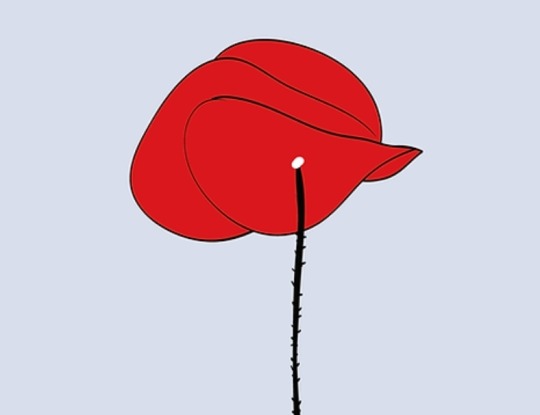
109 notes
·
View notes
Text
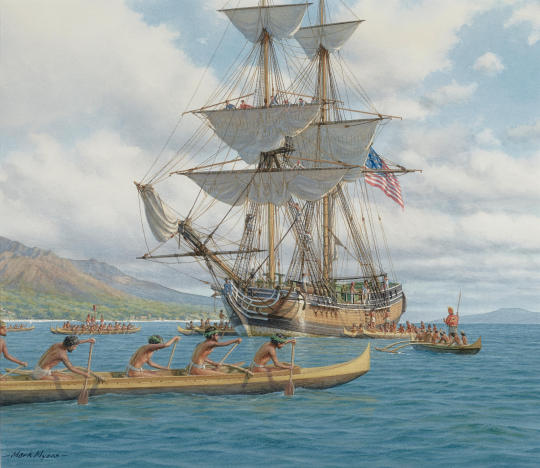
The Hancock off Lahaina, Maui, 1791, by Mark Myers (1945-)
The Boston brigantine Hancock is shown surrounded by native craft as she comes to anchor at the island of Maui in Hawaii on her voyage to the Pacific Northwest in 1791. The view shows the ship off West Maui near Lahaina with the island of Kahoolawe in the right background. Based on the topography of the West Maui Mountains and the perspective of Kahoolawe, the area depicted is near Olowalu, an anchorage just slightly east of Lahaina.
Hancock was typical of the American fur-trading vessels active in establishing the early trade routes linking the Pacific Northwest, Hawaii and China. These early trading voyages would later help to justify America's claims to sovereignty over these areas. The Hancock sailed from Boston under the command of her owner Samuel Crowell in November 1790 bound for the rich seal and otter hunting grounds in the Pacific Northwest. En route, after first stopping at Staten Island to take seals before proceeding around Cape Horn, she arrived in Hawaiian waters during the spring or early summer of 1791. This arrival is depicted in the present work. During this visit a plan by local natives and beachcombing ex-mariners to capture the Hancock was discovered and thwarted by her crew. Hancock then sailed north and east, arriving off the Queen Charlotte Islands on July 14, 1791.
There she joined company with the brigantine Hope, also out of Boston, owned by Thomas H. Perkins and under the command of Joseph Ingraham. In August, 1791 Hancock encountered Captain Robert Gray and Columbia Rediviva at Masset Sound on Graham Island in the northern part of the Queen Charlotte Islands. In October Hancock was back in Hawaiian waters, again in company with Captain Ingraham and Hope. Both ships were bound for Canton with a cargo of seal and otter pelts. It is not known if Hancock and Hope proceeded to China together, but both were at Canton in early 1792.
After successfully marketing her cargo in Canton, Hancock departed China on April 26, 1792 sailing with Hope and the small sealing schooner Grace. They arrived back in the Queen Charlotte Islands on July 3. George Vancouver, on board Discovery, reported encountering Hancock at Nootka Sound in May, 1793. Further data regarding this voyage has not been uncovered. However, it is likely Hancock sailed again to Canton in the winter of 1793 before returning home to Boston via the Cape of Good Hope.
91 notes
·
View notes
Photo

On this day, 25 April 1945, some major cities in Italy were liberated from fascism following a working class uprising and general strike in what has since been immortalised as the country's annual Liberation Day. Other towns and cities were liberated before and afterwards. But on April 25, the cities of Milan and Genoa were liberated. Genoa was the only European city where Nazi forces surrendered to resistance partisans. At 7:30 PM, German general Günther Meinhold and communist factory worker Remo Scappini signed the Nazi surrender agreement. The partisan resistance force in Genoa only consisted of around 5000 fighters, compared with over 10,000 Germans, with thousands more outside the city. The partisans controlled all the major roads going in and out of the city, and they were supported by an insurrection in the city. Some German officers resisted the order to surrender, but by 9 AM on April 26, the resistance announced that the insurrection had succeeded and Genoa had been liberated. We are currently working on a podcast miniseries about the partisan resistance, in conversation with surviving partisan fighters. You can get first listen, and support our work like this funding translations and production costs, by joining us on patreon: https://patreon.com/workingclasshistory Pictured: partisans street fighting in Milan https://www.facebook.com/photo.php?fbid=614604790712740&set=a.602588028581083&type=3
272 notes
·
View notes
Text



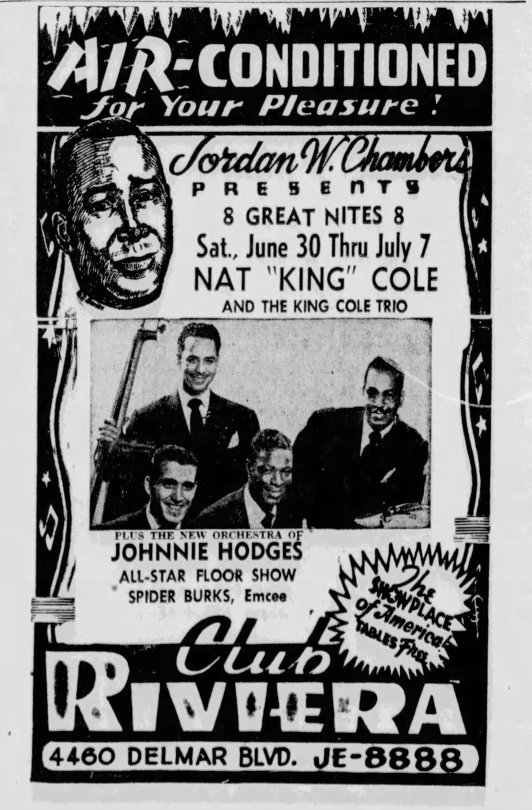



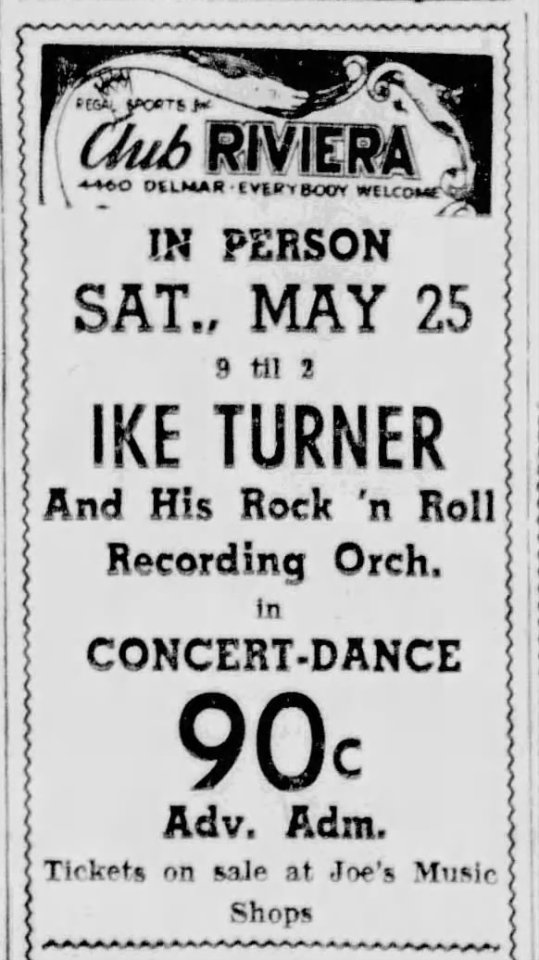
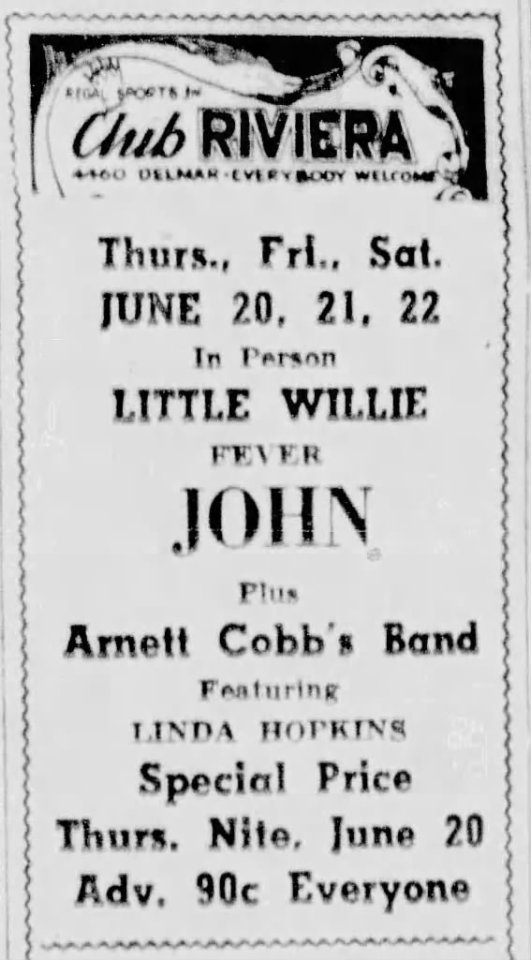


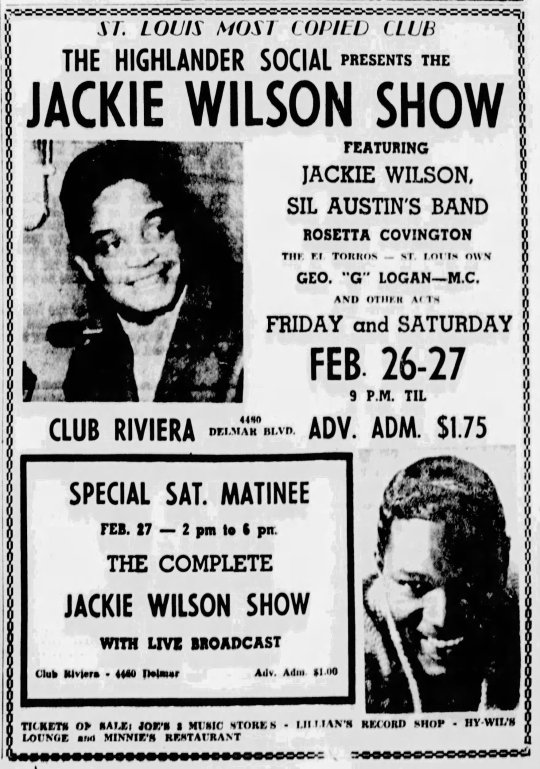
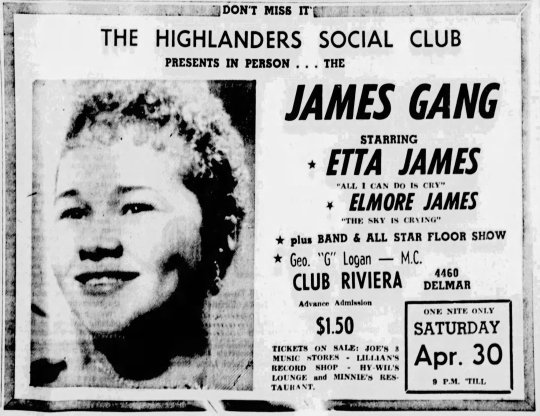
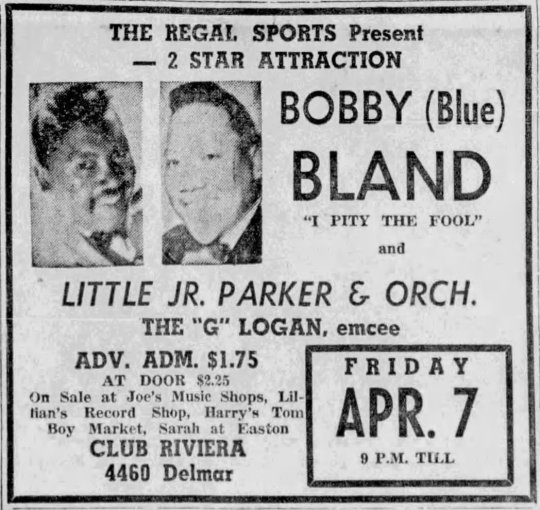
Ads for Club Riviera in St. Louis
Luis Russell / Sister Rosetta Tharpe (January 1945)
Billie Holliday (January 21-28, 1950)
Cab Calloway (January 1, 1951)
Duke Ellington (January 12-19, 1952)
Louis Jordan (May 4-12, 1956) / Count Basie (May 18, 1956)
Dinah Washington (June 26-28, 1956) / Little Richard (July 20-21, 1956)
Ike Turner (May 25, 1957)
Little Willie John (June 20-22, 1957)
Ray Charles (January 10-11, 1958)
B.B. King (August 22-32, 1958)
Jackie Wilson (February 26-27, 1960)
Etta James & Elmore James ( April 30, 1960)
Bobby "Blue Bland / Little Jr. Parker (April 7, 1961)
#club riviera#luis russell#sister rosetta tharpe#billie holiday#cab calloway#duke ellington#louis jordan#dinah washington#ike turner#little willie john#bb king#ray charles#jackie wilson#eitta james#bobby blue bland#st louis#african american
123 notes
·
View notes
Text
Edith Finch Timeline
So I'm still organizing my theories (honestly they're more like a list of unanswered questions than a coherent theory right now) but I think my timeline is pretty much complete now that I've had a chance to go back through the pet cemetery and add all those in.
I do some wild speculating about Odin here that has no canon basis, just spinning ideas.
Things to notice- Just how many deaths happen on or very near birthdays. Not always the birthday of the person who dies and not every time, but suspiciously often.
The pets almost seem to fill in the years when no one human died? Like everything in this game it's nothing definitive enough to base a solid theory on, but it is odd.
TIMELINE
1439 - Earliest possible beginning of the Finch Family Curse based on the Odin viewmaster reel, as this is 500 years prior to the invention of the first viewmaster.
1445 - If the Odin viewmaster is the Model E made in 1955 (which I think it is), this is the start of the curse instead. Not much is happening in Norway during this period, but Vlad the Impaler was at the top of his game this year?
~About 7 generations of Finches dying horribly happens here.~
1880 - Odin is born. At some point between now and his death he writes "The Mysteries of Death and the Thereafter" and "Joining the Great Majority" which both appear to be books about the afterlife.
1896 - Heroic Age of Antarctic Exploration begins with the Belgian Antarctic Expedition and won't end till after WWI. Expeditions are marked by depression, starvation, insanity and scurvy. Many famous expeditions are made by Norwegian teams. Odin is 16.
1911 - A Norwegian expedition is first to reach the South Pole. The British Scott expedition chasing the same goal are lost. Odin is 31.
28 July 1914 - WWI begins, Odin is 34. Norway, "The Neutral Ally", remains neutral on the war but due to economic pressure from Britain commits its merchant marine fleet (one of the largest in the world) to Britain's service. Half the fleet is sunk and 2000 seamen are killed. If Odin was a sailor, he likely served. Alternatively, he may have been one of the wealthy merchants who profited greatly during the war. He clearly has a great deal of money to burn by 1937.
June 17 1915 - Sven is born.
April 8, 1917 - Edie is born.
1935 - At some point between now and Dec 1937, Edie and Sven marry and Sven takes Edith's last name.
1936 - Ingeborg and her newborn Johann Finch die in an unknown manner. Odin is 56, Edie is 19, Sven is 17.
Jan 7 1937 - Odin sets sail for Washington.
Dec 1937 - Arrival on Orcas Island, death of Odin at 57. Molly is born, on the boat? In the Old House? Sven and Edie build the cemetery, and then the house.
1938 - Churpy the budgie joins the family.
1939 - Invention of the viewmaster, earliest point the Odin story could have been recorded.
Sep 1939 - Sep 1945 - WWII. Sven was 24, and may have served or been drafted.
1940 - Burpy the house finch joins the family.
1941 - Churpy dies.
1947 - Christopher the goldfish joins the family.
Oct 31 1947 - Halloween Baby Barbara
Sometime between 1937 and 1947 - Molly's unnamed gerbil joins the family.
Dec 13 1947 - Molly dies of apparent poisoning after eating mistletoe berries, on or very near her 10th bday. She relates hallucinating having become several animals, most notably a cat. Christopher the fish dies shortly after. The fate of her unnamed gerbil is unrecorded, as none of the unattributed headstones are of the right age, but presumably it dies eventually.
1948 - Burpy dies at 8.
April 25 1950 - Sam and Calvin are born.
Aug 26 1952 - Walter is born.
1952 - Lurpy the Cockatiel joins the family.
1955 - Viewmaster Model E released- If this is the one used for Odin's story, that puts the beginning of the curse at 1455.
1956 - Lucy the dog joins the family.
1959 - Bailey the (???) joins the family.
Oct 31 1960 - Barbara dies, allegedly murdered, on her 16th bday. Her boyfriend Rick disappears the same night. The version of her death shared in the game is notably extremely unreliable and raises numerous questions. Rick is seen in a leg cast using crutches. Walter is 8, Sam and Calvin are 10 and notably absent from reported events.
Sept 23 1961 - Calvin dies at 11 falling from a cliff. He is seen wearing a weathered and heavily autographed leg cast. His model shows him with a black eye and several cuts.
1962 - Zoe the (???) joins the family.
1963 - Lurpy dies at 11. (Cockatiels have a life expectancy of 20-25 years)
Aug 26 1964 - Sven dies on Walter's 12th bday, while making a dragon shaped slide. He's 49.
1968 - Walter enters the bunker. He's 16. Durpy the Dove joins the family.
May 7 1968 - Dawn is born.
1969 - Lucy the dog dies.
June 20 1969 - Gus is born.
1970 - Zoe dies
1971 - Purply the Budgie joins the family.
1974 - Coco the (???) joins the family.
Jan 12 1976 - Gregory is born
Dec 7 1977 - Kay files for divorce after arguing with Sam about the curse.
Dec 19 1977 - Gregory drowns in the bath a month before his 2nd bday
1978 - Shadow the cat joins the family.
1979 - Purply dies at 8.
1980 - Rob the Bearded Dragon joins the family. Bob the Snake joins the family.
1981 - Durpy dies at 13.
1982 - Oliver the rabbit joins the family.
Nov 8 1982 - Gus dies, crushed by debris from a storm during Sam's wedding to an unnamed woman.
July 16 1983 - Sam dies, kicked off a cliff by a deer. Dawn is 15.
1984 - Bob dies at 4.
1985 - Daisy the (???) joins the family.
1986-87 Dawn goes to India, meets Sanjay.
1988 - Shadow the cat dies.
Dec 27 1988 - Lewis is born. Furpy joins the family. Tucker the (???) joins the family
1989 - Oliver the rabbit dies.
1991 - Rob dies at 10. Furpy dies.
1992 - Zurpy the Owl joins the family.
May 19 1992 - Milton is born.
1993 - Charlie the cat joins the family. Daisy dies.
1994 - Durpy Jr the Dove joins the family.
1995 - Zurpy dies at 3. Schatzi the (???) joins the family.
Feb 14 1999 - Valentine's Baby Edith. Lowest tide in a thousand years allegedly allows Edie to access the Old House. At some point between now and Nov 2010, three unnamed gerbils join the family, and then die.
Feb 22 2002 - Sanjay dies in an earthquake, eight days after Edith's 3rd bday, Dawn and children return to Finch House. Dawn writes "To Teach and To Learn" at some point in the next few years. At some point between now and 2010, Dawn probably finds a stray cat and names it Molly.
Oct 23 2003 - Milton disappears.
Late 2003 to Early 2004 - Dawn searches for Milton, eventually gives up and seals the rooms for unknown reasons.
March 31 2005 - Walter leaves the bunker and dies, allegedly hit by a train. There are several strange inconsistencies surrounding the circumstances of his death.
2006 - Durpy Jr dies at 12.
2009 - Schatzi dies
Nov 21 2010 - Lewis dies of apparent suicide one month before his 22nd bday.
Nov 28 2010 - A week after Lewis's death, Dawn informs Edie they are leaving the house. After Edie attempts to give Edith a book containing a story about their family which Dawn violently rips away, Dawn flees the house with Edith immediately, leaving Edie and all her belongings behind.
(Molly the cat is not mentioned in regards to the move, so she may have died by this point, but she is not listed in the graveyard, so it's possible she was simply left behind. There is a taxidermy calico in Sam's room, but Sam was dead before Molly could reasonably have joined the family, so this is unlikely to be her. A cat is seen outside human Molly's room in 2016, which may prove she's still alive- but she'd be around 14 years old. An unlikely age for a cat abandoned outdoors for 7 years.)
Nov 29 2010 - Edie is found dead by nursing care workers, and may have killed herself by combining alcohol with her medication, intentionally or otherwise. She's 93, the only member of her family to live longer than her father, who died at 57.
Dec 5 2010 - The date on Edie's tombstone, a week after when she supposedly died.
May (around the 12-18th?) 2016 - Edith becomes pregnant.
Oct 12 2016 - Dawn dies of a chronic illness at 48. Edith is 16 and about 6 months pregnant.
Oct 13 - 19 2016 - Edith returns to the Finch House at 22 weeks pregnant.
Jan 18 2017 - Edith dies in childbirth a month before her 18th bday. Christopher is born (possibly named for Molly's goldfish?).
2027? - At some point in the future, a young Christopher returns to the house, which has changed since the last time it was seen. He is wearing a cast.
A note on unrecorded pets- There are additionally 5 (possibly 6?) unmarked pet graves in the cemetery. One of the blank stones presumably belongs to Rob the bearded dragon, who has a memorial in Edie's room but no gravestone. One is marked as a fish and another is a rabbit, with no names or dates. One is a knocked over and unreadable sign of the same kind used for the birds, indicating it may be an otherwise unrecorded bird. There is also a statue of a frog- the knocked over sign may instead refer to an unrecorded pet frog, or the frog statue might be a separate gravestone, or simply a decoration. This leaves one blank headstone with no indication of what might lie beneath it. Let's assume it's a mass grave for gerbils.
29 notes
·
View notes
Text
A OGNI COSTO

"Aldo dice 26 x 1". Era questo il messaggio in codice diramato il 24 aprile 1945 dal CLNAI con l'ordine di insurrezione generale. L'ora X fu fissata per l'una di notte del 26 aprile. Già il 10 del mese il Comando delle Brigate Garibaldi aveva messo in allerta tutti i combattenti per prepararsi all'insurrezione del nord Italia e precedere l'arrivo degli Alleati. L'insurrezione era da effettuarsi a ogni costo, senza accettare accordi o tregue con il nemico. Furono stesi piani per entrare nelle città, per salvaguardare le fabbriche e impedire la fuga dei nazifascisti. Così, le brigate partigiane di montagna scesero in pianura e marciarono sui centri principali, mentre in città iniziarono gli scioperi e l'occupazione dei palazzi principali con i reparti GAP e SAP a coordinare la lotta popolare. Iniziava così la Liberazione d'Italia.
24 notes
·
View notes
Text
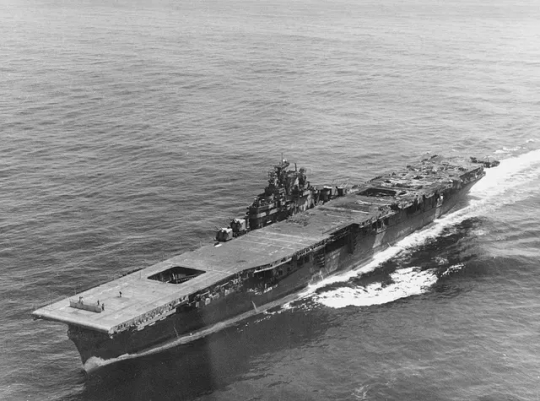
The heavily damaged USS Franklin approaching New York, 26 April 1945
19 notes
·
View notes
Text

In Nazi concentration camps, each prisoner was required to wear a downward-pointing, equilateral triangular cloth badge on their chest, the color of which identified the reason for their imprisonment; A pink triangle was established for prisoners identified as homosexual men, which also included bisexual men and transgender women. The pink triangles were slightly larger than the other colored triangles so that guards could identify them from a distance. It is said that those who wore the pink triangles were singled out by the guards, and when the guards were finished with them, some of the other inmates would harm them as well. At the end of the war, when the concentration camps were finally liberated, virtually all of the prisoners were released except those who wore the pink triangle. Those with a pink triangle on their pocket were put back in prison and their nightmare continued. Prisoners imprisoned for homosexuality were re-incarcerated by the Allied-established Federal Republic of Germany. The Nazi amendments to Paragraph 175, which turned homosexuality from a minor offense into a felony, remained intact in East Germany until 1968 and in West Germany until 1969, though West Germany continued to imprison those identified as homosexual until 1994. 1994, only 26 years ago. The holocaust did not end for everyone in 1945.
https://www.snopes.com/fact-check/gay-prisoners-germany-wwii/
https://www.history.com/news/pink-triangle-nazi-concentration-camps
http://auschwitz.org/en/history/categories-of-prisoners/homosexuals-a-separate-category-of-prisoners/robert-biedron-nazisms-pink-hell/
https://en.m.wikipedia.org/wiki/Paragraph_175
https://encyclopedia.ushmm.org/content/en/article/classification-system-in-nazi-concentration-camps
Posted by Jenni B Wyrick on Facebook April 27, 2020.
#queer history#nazis#gay history#homosexual history#nazi concentration camps#pink triangle#homosexual#bisexual#transgender history#transgender
590 notes
·
View notes
Text

Boeing B-17G Flying Fortress "Madam Shoo Shoo" (43-37786) at Kingman, Arizona for disassembly and reduced to aluminum scrap.
History on this B-17: "Delivered: Cheyenne 21/5/44; Hunter 2/6/44; Grenier 14/6/44; Assigned: 551BS/385BG [HR-Z] Gt Ashfield 16/6/44; taxi accident Pilot: Albert Potter 17/1/45; Returned to US: Bradley 26/6/45; 4168 BU Sth Plains 28/6/45; Scrapped: Kingman 23/11/45; Fate: Returned to the USA (26 June 1945)"
-information from b17flyingfortress.de: link
Date: April 1947
Photographed by Peter Stackpole, LIFE Magazine
LIFE Magazine Archives: 116587905
#Boeing B-17 Flying Fortress#B-17G#B-17#bomber#USAF#scraping#Kingman#Arizona#post war#April#1947#my post
8 notes
·
View notes
Text





Finnish Army WW2 Medium Tanks
Another Sequel of Of Great Projects about Weapons and Heavy Machinery That Used During Winter War (1939-1940) & Continuation War (1941-1944). This Time Around Covering Medium Tanks that used by Finn. Like A Previous Project Finnish Army During WW2 Relied Captured Soviets Tanks, Obsolete WW1 Products Or Licensed Products From Allied Countries Like Germany
Disclaimer:Due Heavy Censorship Regarding Swastika Usage in Western Society, The Details of The Tanks Are Replaced With Roundel Instead of Finnish Hakaristi.
Here We go
LINK
Panzerkampfwagen IV Ausführung J
The Panzerkampfwagen IV Ausführung J, also known as Gerät 550 or Sonderkraftfahrzeug 161/2, was the last variant of the famed Panzer IV. It was produced from January 1944 to the last days of April 1945 in the Nibelungenwerk (Ni-Werk) factory in Sankt Valentin, northern Austria.
This variant was characterized by many modifications made to the previous models in order to speed up production and save on valuable raw materials.
Sturmgeschütz III Ausführung G
The Sturmgeschütz III (StuG III) assault gun was Germany's most-produced fully tracked armoured fighting vehicle during World War II, and second-most produced German armored combat vehicle of any type after the Sd.Kfz. 251 half-track. It was built on a slightly modified Panzer III chassis, replacing the turret with an armored, fixed superstructure mounting a more powerful gun. Initially intended as a mobile assault gun for direct-fire support for infantry, the StuG III was continually modified, and much like the later Jagdpanzer vehicles, was employed as a tank destroyer.
This particular model. the G variant of the StuG III tank destroyer comes with thicker armour of up to 80 mm on the front glacis and a 75 mm StuK 40 L/48 gun that gives the vehicle characteristics on par with a Panzer IV. With this cannon on a low-profile construction due to its casemate design, the StuG III G can prove to be a formidable vehicle in the ambush role.
Soviet T-34/85
The T-34 is a Soviet medium tank from World War II. When introduced, its 76.2 mm (3 in) tank gun was more powerful than its contemporaries,[8] and its 60-degree sloped armour provided good protection against anti-tank weapons. The T-34 had a profound effect on the conflict on the Eastern Front, and had a long-lasting impact on tank design. The tank was praised by multiple German generals when encountered during Operation Barbarossa, although its armour and armament were surpassed later in the war.
Replacing many light and medium tanks in Red Army service, it was the most-produced tank of the war, as well as the second most-produced tank of all time (after its successor, the T-54/T-55 series). With 44,900 lost during the war, it also suffered the most tank losses ever. Its development led directly to the T-44, then the T-54 and T-55 series of tanks, which in turn evolved into the later T-62, that form the armoured core of many modern armies. T-34 variants were widely exported after World War II, and as recently as 2010 more than 130 were still in service.
This Particular Model: The T-34-85 (German designation: T-34/85) was a major improvement with an 85 mm gun in a three-man turret.
Soviet T-28 Model 1938
The T-28 was a Soviet multi-turreted medium tank. The prototype was completed in 1931, and production began in late 1932. It was an infantry support tank intended to break through fortified defences. The T-28 was designed to complement the heavier T-35 (also multi-turreted), with which it shared turret designs. The type did not have great success in combat, but it played an important role as a development project for Soviet tank designers. A series of new ideas and solutions that were tried out on the T-28 were later incorporated in future models.
This Particular Model is T-28 Model 1938 (T-28B) – version with the improved L-10 76.2 mm gun (from 16.5 to 26 calibres). Some older tanks were also backfitted with spare L-10 guns. The rod antenna replaced the horseshoe in early 1939.
#the sims 4#the sims#the sims 4 custom content#ts4 cc#ts4military#the sims 4 military#ts4#the sim#the sims 4 cc#ts4cc#winter war#finnish#suomi#soviet union#the sims 4 decades challenge#sims 4 decades#ts4 decades challenge#1940s#1930s vintage#1930s#the sims 4 ww2#sims 4 war#finland
24 notes
·
View notes
Text
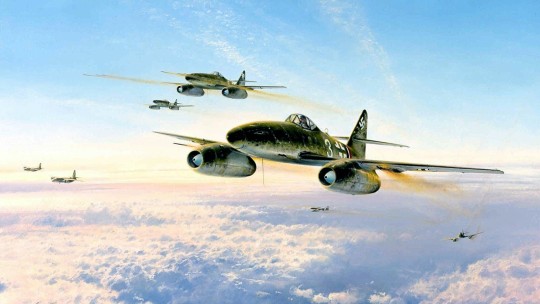
1945 04 Stormbirds over the Reich - Robert Taylor
In his inimitable style, Robert Taylor sets the scene at 20,000 feet over Southern Germany on a late afternoon in April 1945, Adolf Galland and a group of his JV-44 Wing Me262s as they make a high-speed rocket assault on a formation of B-26 Marauders. Diving from a 6000 ft. height advantage to 1500 ft. below and behind the bomber formation, the 262s made a fast approach, climbing to the level of the bombers before loosing off their 24 R4M rockets in one salvo at 600 yards; a long burst of cannon fire followed at 150 yards, and a quick climbing exit from the scene.
Galland's Me262 is captured by Robert Taylor at the moment of release of his rocket salvo, the burst of flame and smoke visible under each wing as the deadly missiles are launched. Above, a second 262 pilot launches his rockets while a third lines up his sights on the B-26s ahead. Below two more swoop into the attack, one closing on the straggling Marauders on the left of the picture.
30 notes
·
View notes
Text

#onthisday in 1941 the B-17E Flying Fortress flew for the first time. This featured an increase in armament over previous variants.
@classicwarbirds via X
Boeing B-17 Flying Fortress | Classic Warbirds
Responding to the specification released by the United States Army in May 1934 calling for a multi-engined bomber that was able to carry a bomb load of 2,000lb between 1,020 and 2,200 miles, at a speed of 200 - 250 mph, with a deadline of August 1935 for a prototype of the aircraft to be ready for testing. Boeing submitted their Model 299, which would be powered by four engines. Design of the aircraft began midway through June 1934, and just over a year later, on the 16th July 1935 at Boeing Field, the aircraft was introduced to the press, with the headlines the next day proclaiming a '15-ton Flying Fortress' leading to Boeing registering it as the Model 299 name.
Twelve days later on the 28th July 1935 the B-17 made its first flight, before being flown to Wright Field for testing and evaluation a few weeks later. By making this flight the B-17 met two objectives of the United States Army specification, firstly the journey was 2,100 miles long and was done at an average speed of 252 mph. The prototype comprised armament of five machine guns and could carry more than double the required bomb load of 2,000lb with a 4,800lb maximum load and was powered by four 750-hp Pratt & Whitney R-1690 radial engines. However during testing a setback occurred on the 30th October 1935, when the prototype crashed on take-off, an investigation was to later conclude that the controls had been locked when take-off was attempted. Despite this setback the United States Army Air Corps ordered thirteen YB-17s, later to be called Y1B-17s, as a result of the successful testing before the accident.
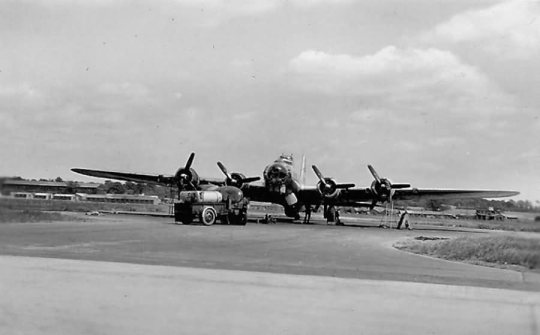
The 2nd December 1936 saw the first Y1B-17 fly, with a few improvements compared to the prototype, the aircraft would now be powered by 930-hp Wright GR-1820-39 Cyclone radials and could accommodate nine crew members. The USAAC's 2nd Bombardment Group based at Langley Field received twelve aircraft during the first eight months of 1937. The other Y1B-17 of the thirteen originally ordered was sent for further testing at Wright Field. A fourteenth example had also been built for testing the strength of the airframe but was later fitted with 1,000-hp engines with turbochargers. After initial problems, it finally flew on the 29th April 1938, with an improvement on its maximum altitude and speed. As this new version was the first variant to enter operational service it was designated the B-17A. Following shortly after was the B-17B, which, whilst almost identical to the B-17A, featured a larger rudder. This first flew on the 27th June 1939 and just over a year later, on the 21st July 1940, the new B-17C flew with 1,200-hp engines.
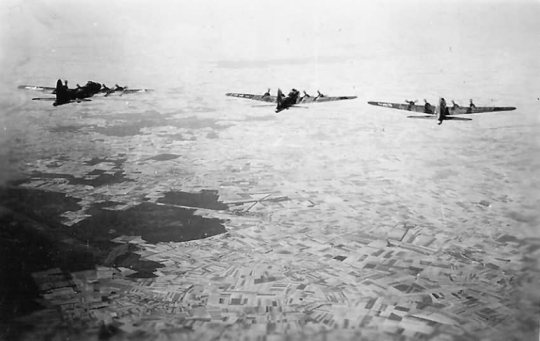
It was with the Royal Air Force that the B-17 was to first experience combat during the Second World War (1939 - 1945) when No. 90 Squadron, which reformed on the 7th May 1941 at RAF Watton, received the B-17C, designated Fortress I that same month. On the 8th July 1941 they took part in their first RAF raid against the naval barracks at Wilhelmshaven, Germany, however, bombing from 30,000 ft they failed to hit the target. Over the next two months another 26 attacks were made on various German targets, and with eight Fortress Is lost due to combat or accidents the Fortress I proved unsatisfactory for use by Bomber Command for daylight bombing. The remaining Fortress Is were transferred to Coastal Command. As a result of the poor performance of the B-17 over Europe a number of areas where the aircraft could be improved were found, these included more defensive armament to combat attacks from German fighters and a higher service celling. By the end of 1941, the United States was drawn into the Second World War after the Japanese attack on Pearl Harbor on the 7th December 1941.

The introduction of the B-17D, with additional armour and self-sealing tanks, and the B-17E, which flew for the first time on the 5th September 1941. The United States Army Air Force first raid over Europe was on the 17th August 1942, when twelve B-17Es escorted by Supermarine Spitfires of the Royal Air Force attacked the marshalling yards at Rouen in France, only two aircraft sustained minor damage and the mission was a success.

Flying for the first time on the 30th May 1942, the B-17F featured a redesigned nose, more armour and increased fuel capacity. Along with the B-17E it would be the Flying Fortress versions most extensively used by the Eighth Air Force. However mounting losses during the daylight raids were to show that the Flying Fortress either on its own or flying in formation could not defend themselves. Although the B-17G appeared with a gun turret in the nose section to limit the aircraft's vulnerability to head on attacks, daylight raids deep into Germany saw heavy losses. The introduction of the North American P-51 Mustang and Republic P-47 Thunderbolt equipped with external fuel tanks saw losses reduced.
The Boeing B-17 Flying Fortress was used wherever US forces were. In the Pacific theatre of war they were used for close-support bombing, patrol and reconnaissance. A few B-17's were produced for special operations and purposes and despite production totalling 12,731, only a few hundred would stay in service at the conclusion of the Second World War.
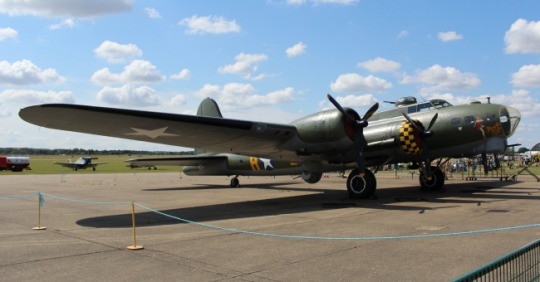
Technical Details
Click on the aircraft image to view a larger version.
Top Speed Range Service Ceiling Armament
B-17A 295 mph 3,600 miles 38,000 ft five 0.30-in machine-guns
eight 600lb bombs
B-17B 292 mph 3,600 miles 36,000 ft six 0.50-in machine-guns
one 0.30-in machine-gun
four 1,100lb bombs
B-17C 323 mph 3,400 miles 37,000 ft five 0.50-in machine-guns
one 0.30-in machine-gun
4,800lb bombs
B-17D 323 mph 3,400 miles 37,000 ft five 0.50-in machine-guns
one 0.30-in machine-gun
4,800lb bombs
B-17E 317 mph 3,200 miles 36,000 ft eight 0.50-in machine-guns
one 0.30-in machine-gun
4,200lb bombs
B-17E side profile image
B-17F 325 mph 2,800 miles 37,500 ft eleven 0.50-in machine-guns
8,000lb bombs
B-17G 302 mph 3,400 miles 35,600 ft twelve 0.50-in machine-guns
8,000lb bombs
B-17G side profile image
XB-38 Sole B-17E tested with a Allison V-1710V engine.
YB-40 292 mph 2,260 miles 29,200 ft at least fourteen 0.50-in machine-guns
C-108 Four aircraft converted and used as cargo carriers and V.I.P transport.
F-9 Designation for a number of B-17s converted into photo reconnaissance aircraft.
BQ-7 Aphrodite B-17s converted into drones.
PB-1 Designation given to B-17s used by the United States Navy.
13 notes
·
View notes